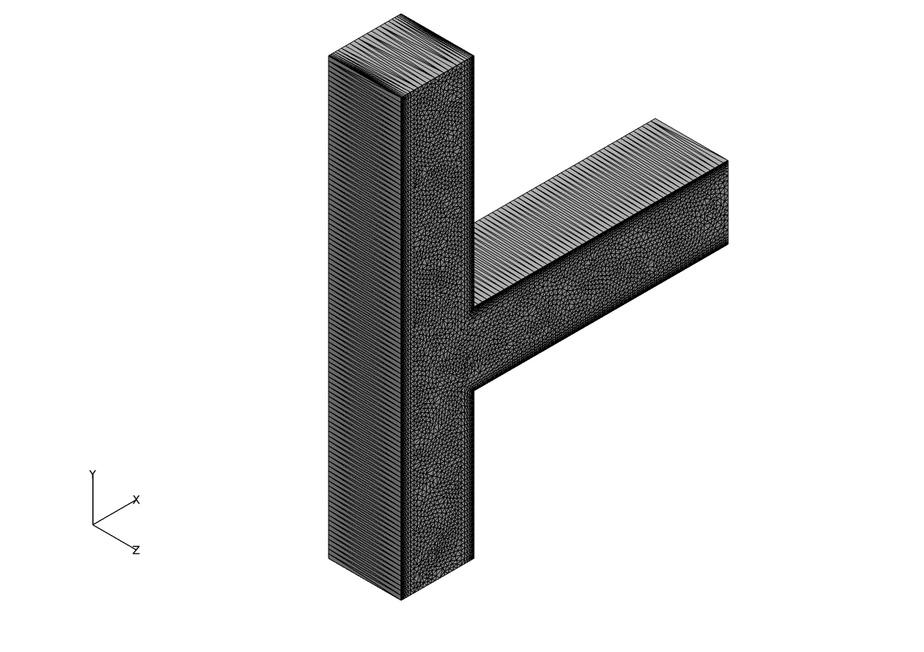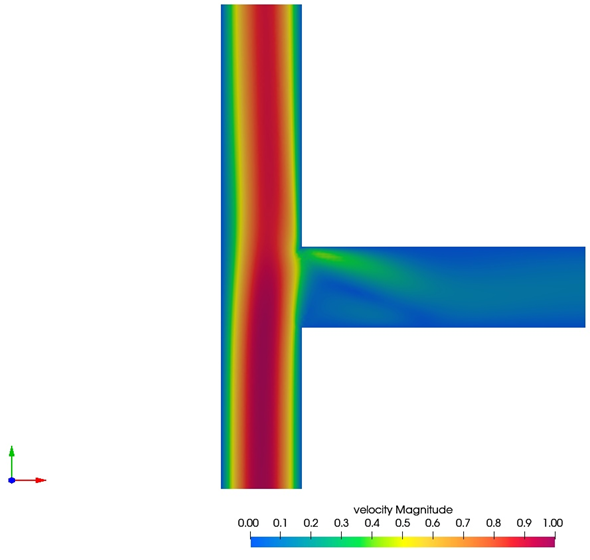Laminar Flow Past a 90° T-Junction
In this application, AcuSolve is used to simulate laminar flow through a channel with two outlets forming a T-junction. AcuSolve results are compared with experimental results adapted from Hayes and others (1989). The close agreement of AcuSolve results with experimental results validates the ability of AcuSolve to model cases with multiple outlet paths.
Problem Description


AcuSolve Results

| Experimental fractional flow | AcuSolve fractional flow | Percent deviation from experimental | |
|---|---|---|---|
| Fractional flow exiting the upper branch | 0.887 | 0.889 | 0.332 |
Summary
The AcuSolve solution compares well with experimental results for flow past a T-junction. In this application, flow is driven by a fixed flow rate at the inlet to the main branch. A portion of the flow from the main branch is diverted into the right branch of the T-junction, giving rise to recirculation just downstream of the junction. This recirculation collapses before the flow exits the side branch. The AcuSolve result for fractional flow exiting the top branch is within 0.33 percent of the experimental results.
Simulation Settings for Laminar Flow Past a 90° T-Junction
SimLab database file: <your working directory>\T_junction_laminar\T_junction_laminar.slb
Global
- Problem Description
- Solution type - Steady State
- Flow - Laminar
- Auto Solution Strategy
- Relaxation factor - 0.2
- Material Model
- Air
- Type - Constant
- Density - 1.0 kg/m3
- Viscosity - 0.003333 kg/m-sec
Model
- Air
- Volumes
- Fluid
- Element Set
- Material model - Air
- Element Set
- Fluid
- Surfaces
- Inflow
- Simple Boundary Condition
- Type - Inflow
- Inflow type - Average Velocity
- Average velocity - 0.6667 m/sec
- Simple Boundary Condition
- Max_Z
- Simple Boundary Condition - (disabled to allow for periodic conditions to be set)
- Min_Z
- Simple Boundary Condition - (disabled to allow for periodic conditions to be set)
- Outflow
- Simple Boundary Condition
- Type - Outflow
- Simple Boundary Condition
- T_Out
- Simple Boundary Condition
- Type - Outflow
- Simple Boundary Condition
- Walls
- Simple Boundary Condition
- Type - Wall
- Simple Boundary Condition
- Inflow
- Periodics
- Periodic 1
- Periodic Boundary Condition
- Type - Periodic
- Periodic Boundary Condition
- Periodic 1
References
R. E. Hayes, K. Nandkumar, and H. Nasr-El-Din. "Steady Laminar Flow in a 90 Degree Planar Branch". Computers and Fluids 17(4): 537-553. 1989.